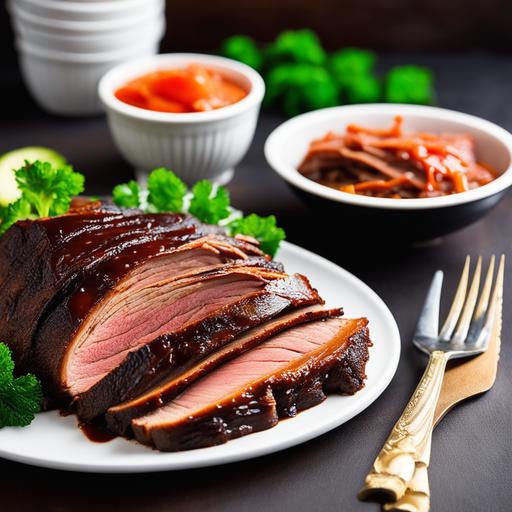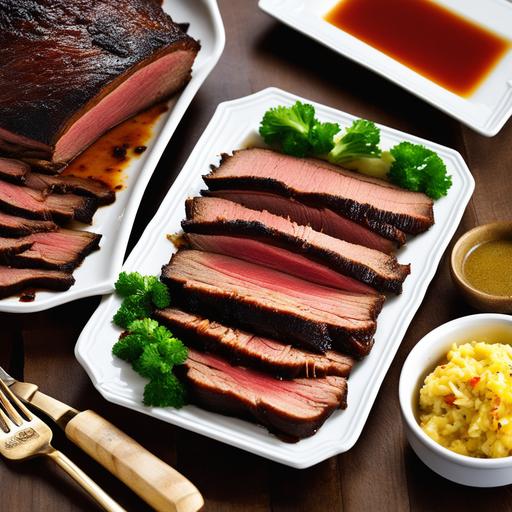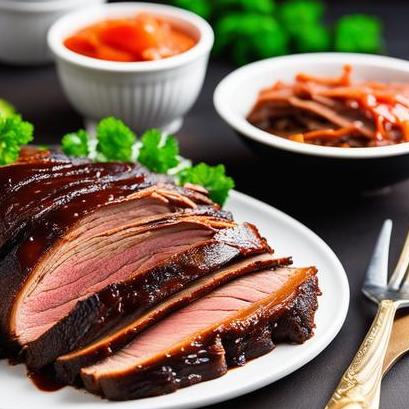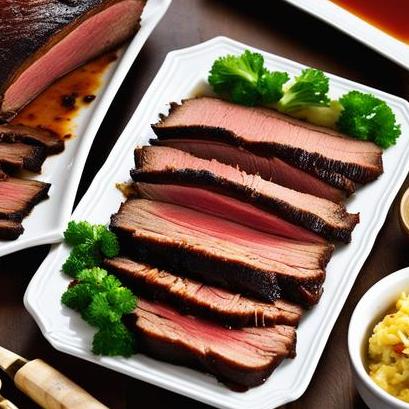
Tender Brisket Oven Recipe: A Guide To Mouthwatering Perfection
Are you ready to embark on a culinary journey that will tantalize your taste buds and leave you craving for more? Look no further, because we have the perfect recipe for you – the tender brisket oven recipe! With its rich flavors, juicy texture, and melt-in-your-mouth tenderness, this dish is sure to impress even the most discerning food connoisseurs. In this comprehensive guide, we will delve into the intricate details of selecting the right cut of meat, cleaning and preparing it, understanding the food science behind achieving tenderness, checking for doneness, and exploring variations to make this dish truly your own.
1. Brisket Selection: The Foundation of a Great Dish
Selecting the right cut of brisket is crucial for achieving that perfect balance of tenderness and flavor. While there are two primary cuts – the flat and the point – the flat cut is generally preferred for its uniform thickness and consistent marbling. Look for a brisket that has a generous marbling of fat, as this will keep the meat moist during the cooking process, resulting in a succulent final product.
2. Cleaning and Preparation: The Key to Succulent Brisket
Before diving into the cooking process, proper cleaning and preparation are essential to ensure a deliciously tender and safe-to-eat brisket. Follow these steps to achieve excellent results:
2.1 Cleaning the Brisket
-
Start by rinsing the brisket under cold running water, gently rubbing away any debris or excess blood.
-
Pat the brisket dry with paper towels to remove any excess moisture.
2.2 Trimming the Brisket
- Trim the excess fat from the surface of the brisket, leaving about a ¼ inch layer to enhance flavor and moisture retention.
2.3 Seasoning the Brisket
-
Apply a generous amount of kosher salt and freshly ground black pepper to all sides of the brisket, ensuring even seasoning.
-
Optional: You can incorporate your preferred dry rub or spice blend to add an extra layer of flavor. Some popular choices include garlic powder, paprika, onion powder, and brown sugar.
3. Understanding the Science Behind Tenderizing Brisket

To achieve that sought-after tenderness, it’s important to understand the science behind the cooking process. Brisket is a tough cut of meat that contains a significant amount of connective tissue and collagen. The key to tenderizing the brisket lies in breaking down this tough muscle tissue and transforming it into gelatin. This transformation occurs through a combination of low and slow cooking, allowing the collagen to convert into gelatin, resulting in a tender, juicy brisket.
4. Cooking Techniques: Low and Slow for Flavorful Perfection

There are numerous cooking techniques to choose from when it comes to brisket, but the most revered method involves slow roasting in the oven. This technique allows the flavors to meld together while the lower temperature ensures a moist and tender brisket. Follow these steps for a truly mouthwatering experience:
4.1 Preheating the Oven
- Preheat your oven to 275°F (135°C).
4.2 Choosing the Right Pan
-
Select a roasting pan or an oven-safe skillet that comfortably accommodates the size of your brisket.
-
Ensure the pan has high sides to prevent any drippings or juices from spilling over.
4.3 Adding Liquid for Moisture
-
Place a layer of onions, carrots, and celery at the bottom of the pan to elevate the brisket, preventing it from sitting directly in its own juices.
-
Add beef broth or water to the pan, carefully avoiding the top of the brisket, to create a moist cooking environment.
4.4 Slow Roasting for Flavorful Tenderness
-
Place the seasoned brisket on top of the bed of vegetables in the roasting pan.
-
Cover the pan tightly with foil, ensuring no steam can escape.
-
Slow roast the brisket in the preheated oven for approximately 6 hours, depending on the size and thickness of the brisket. Remember, patience is key!
5. Doneness Checks: Ensuring a Perfectly Cooked Brisket

Despite having a set cooking time, it’s crucial to conduct regular doneness checks to ensure that your brisket reaches the desired level of tenderness. Here are a few methods to assess the doneness of your brisket:
5.1 Probe Test
-
Insert a probe thermometer into the thickest part of the brisket without touching the bone.
-
The internal temperature should reach around 200-205°F (93-96°C) for optimum tenderness.
5.2 Fork Test
-
Carefully insert a fork into the brisket and twist it slightly.
-
If the fork smoothly and easily goes in and out, with little resistance, the brisket is done.
5.3 Feel Test
-
Gently press down on the thickest part of the brisket with your finger.
-
If the meat springs back slightly, it indicates that it’s cooked to perfection.
6. Variations: Making the Brisket Your Own

While the classic oven-roasted brisket is a culinary delight on its own, there are endless variations to explore, allowing you to put your own creative twist on this timeless recipe. Here are a few ideas to inspire your culinary adventures:
6.1 Smoked Brisket
- Utilize a smoker instead of an oven to infuse your brisket with a mouthwatering smoky flavor. Follow the same cleaning, seasoning, and slow-roasting techniques, adjusting the cooking times as per the smoker’s instructions.
6.2 Barbecue-Style Brisket
- After slow roasting the brisket, slather it generously with your favorite barbecue sauce and finish it on a grill or under the broiler for a delightful caramelized crust.
6.3 Ethnic Flair
- Experiment with various spice blends, marinades, or rubs inspired by different cuisines. Whether it’s Tex-Mex, Asian, Mediterranean, or Indian flavors, the choice is yours!
7. Recipe: The Ultimate Tender Brisket
Without further ado, here’s a basic recipe to guide you on your tender brisket oven adventure:
Ingredients:
-
1 (4-5 lb) flat cut beef brisket
-
Kosher salt and freshly ground black pepper to taste
-
Preferred dry rub or spice blend (optional)
-
2 onions, roughly chopped
-
2 carrots, roughly chopped
-
2 celery stalks, roughly chopped
-
2 cups beef broth or water
Instructions:
-
Preheat your oven to 275°F (135°C).
-
Rinse the brisket under cold running water and pat dry with paper towels.
-
Trim excess fat, leaving a ¼ inch layer for flavor and moisture retention.
-
Season the brisket generously with kosher salt and freshly ground black pepper, incorporating any optional dry rub or spice blend.
-
Place the onions, carrots, and celery in the bottom of a roasting pan.
-
Carefully place the seasoned brisket on top of the vegetables in the pan.
-
Pour beef broth or water into the pan, ensuring it does not touch the top of the brisket.
-
Cover the roasting pan tightly with foil, sealing in the moisture.
-
Slow roast the brisket in the preheated oven for approximately 6 hours, or until desired tenderness is reached.
-
Conduct doneness checks using the probe, fork, or feel test to ensure it’s perfectly cooked.
-
Once fully cooked, remove the brisket from the oven and let it rest, covered, for 15-20 minutes before slicing against the grain.
-
Serve hot and enjoy the delectable tenderness of your homemade brisket.
Now that you have all the knowledge, techniques, and inspiration at your disposal, it’s time to embark on your tender brisket oven recipe adventure. Enjoy the process, savor the flavors, and impress your family and friends with this mouthwatering and tender delight!
Sources
FAQS On Tender Brisket Oven Recipe
What Cut Of Beef Should I Use For A Tender Brisket Oven Recipe?
For a tender brisket oven recipe, it is recommended to use a beef brisket. This cut comes from the lower chest of the cow and is known for its flavorful and tender meat when cooked properly.
How Should I Prepare The Brisket Before Cooking It In The Oven?
Before cooking a brisket in the oven, it is important to properly prepare the meat. Start by trimming off any excessive fat from the brisket, leaving a thin layer to add flavor and moisture during cooking. Additionally, you can marinate the brisket in a mixture of your choice for a few hours or overnight to enhance its flavor.
What Is The Ideal Temperature To Cook A Tender Brisket In The Oven?
To achieve a tender and moist brisket, it is recommended to cook it at a low and slow temperature. Set your oven to 275°F (135°C) to ensure even cooking. This low temperature allows the connective tissues in the brisket to break down slowly, resulting in a tender and juicy final product.
How Long Should I Cook A Tender Brisket In The Oven?
The cooking time for a tender brisket in the oven can vary depending on the size of the cut and the specific recipe. As a general guideline, a 3-4 pound brisket will usually take about 4-5 hours to cook at 275°F (135°C). However, it is recommended to use a meat thermometer to check the internal temperature, aiming for around 200°F (93°C) for a tender and fully cooked brisket.
Should I Cover The Brisket While Cooking It In The Oven?
Yes, it is generally advised to cover the brisket while cooking it in the oven. You can use aluminum foil or a lid for the roasting pan to keep the moisture trapped, preventing the brisket from drying out. This helps create a delicious tender result by allowing the meat to cook in its own juices and retain its natural flavors.



